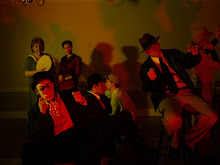
When speaking in real life, we pause, we interrupt, we overlap, we start and stop. If we are to recreate life onstage, the same speech patterns should exist. But do they? Often language onstage is very polite and neat with each performer taking his turn, rarely fishing for words or ideas.
A playwright friend of mine once told me she spent every day listening to the way people talk on the bus and every night trying to capture that on paper. It is an age old challenge tackled by playwrights, directors and actors. How to talk like real people onstage.
Shakespeare sometimes included directions on how to speak his lines in the lines themselves. Hamlet gives the players the instruction to “Speak the speech, I pray you, as I pronounc'd it to you, trippingly on the tongue.” If only there were a Hamlet in every play to convey the playwright’s wishes.
Pinter makes a heroic attempt to help the actors speak the words as he hears them in his head by loading his scripts with pauses, silences, ellipses and dashes. Numerous essays and books have been written to explain what each of these designations imply, but which book or essay to follow becomes the dilemma.
Sometimes the reality slips in during the rehearsal process. There was a wonderful overlapping of lines in Red Tape’s Enemy of the People. Peter Stockman is arguing with his sister and states “You are contractually obligated to receive the approval of the commission before disclosing information to the public” to which Tammy replies “I have the right to speak the truth.” Even though this was not written as an overlapping line, it evolved into one during the rehearsal process. The overlapping built the tension and accentuated each character’s emotional investment in the argument. Rather than seeing two people expressing their opinions one after the other, you saw each person verbally swinging at the other simultaneously, creating one of the most electrifying exchanges in the show.
In Mouse in a Jar, Matyna Majok has created an inspired shorthand which gives the actors and director a clear roadmap of how she hears the voices. Below is her “Dialogistics”.
Brackets [ ] indicate words unspoken but intended.
Slashes / indicate overlap or quickly followed speech.
Double-columned dialogue is spoken simultaneously.
Non-traditional spacing and floating words are requests for poetics and extra syllables. Speed bumps, in essence. Please feel encouraged to experiment – they’re mostly suggestions.
With this innovative scripting, Matyna has made great strides in bridging the gap between the speech we hear in public and the speech we hear on stage.
Come hear the speech as Matyna intended it to be presented.
Errol McLendon
Company Member
Mouse in a Jar runs October 5-31, 2009.
Purchase tickets through our website.


No comments:
Post a Comment